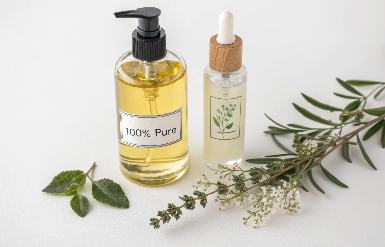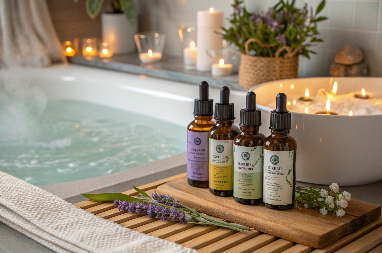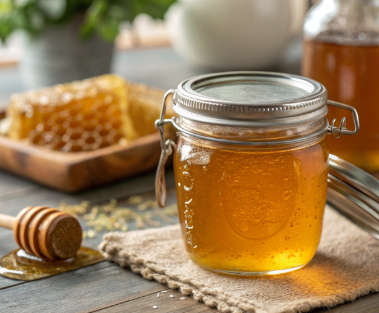Baths are the perfect escape—but add the right essential oils, and they become a full-body therapy.
The best essential oils for aromatherapy baths include lavender for relaxation, eucalyptus for respiratory support, and ylang ylang for emotional balance. Each offers unique benefits when properly diluted in a carrier.
For beauty brands, spa professionals, or wellness creators, essential oil baths are more than just a luxury—they’re a therapeutic tool, a retail opportunity, and a customer experience enhancer. Whether you're crafting bath kits or sourcing bulk oils, knowing which oils work best—and how to use them safely—can elevate your product line and your customers' wellbeing.
Which essential oil is best for a bath?
Lavender gets all the attention—but it’s not the only option.
Lavender is the most popular essential oil for baths due to its calming properties, but other top contenders include eucalyptus, peppermint, rose, and frankincense depending on the desired effect.
Possible Side Effects: Lavender in Your Bath
While lavender essential oil is generally considered safe for most bath lovers, a few potential side effects are worth keeping in mind—especially if you’re new to aromatherapy or have sensitive skin.
- Skin Sensitivity:Undiluted or high concentrations of lavender oil may cause irritation, redness, or rashes. Always dilute with a carrier oil before adding it to your bath.
- Headache or Nausea:In rare cases, the strong aroma can trigger headaches or mild nausea in those sensitive to fragrances.
- Digestive Upset:Accidentally ingesting bath water with oil droplets (not recommended!) can sometimes upset your stomach.
- Increased Appetite:Some users note a mild increase in appetite after aromatherapy sessions, although this varies.
If you’re trying lavender for the first time, do a patch test or start with a small amount. And as always, if you have allergies, sensitive skin, or are pregnant, consult your healthcare provider before diving in.
Dive Deeper: Top Essential Oils for Bath Therapy
| Essential Oil | Best For | Bath Benefits |
|---|---|---|
| Lavender | Sleep, stress, anxiety | Calms nerves, supports restful sleep |
| Eucalyptus | Congestion, muscle relief | Clears sinuses, invigorates body |
| Ylang Ylang | Mood, sensuality | Boosts mood, lowers blood pressure |
| Rose | Skin hydration, romance | Softens skin, enhances emotional comfort |
| Frankincense | Meditation, grounding | Eases tension, promotes mindfulness |
| Peppermint | Fatigue, cooling | Refreshes, soothes sore muscles |
PauPack Tip: When creating bath oil blends, we help brands choose oils based on skin safety and scent harmony—pairing them with custom dropper bottles, bath soaks, and refill kits for cohesive product lines.
Precautions: Eucalyptus Essential Oil in Baths
Sensational as eucalyptus can be, it’s important to approach it with care—especially in the bath.
Eucalyptus essential oil is potent and can cause skin irritation, particularly for those with sensitive skin.Always dilute it thoroughly in a carrier oil before adding to water, and perform a patch test on a small area first. If redness, itching, or discomfort occurs, discontinue use immediately.
Keep in mind: Less is more with powerful oils like eucalyptus. Avoid contact with eyes and keep out of reach of children and pets. Those with asthma, epilepsy, or certain medical conditions should consult a healthcare professional before indulging in eucalyptus-infused soaks.
Potential Side Effects of Frankincense Essential Oil in Baths
Frankincense may be beloved for its grounding, meditative aroma, but it isn’t without its cautions—especially in the bath.
Common side effects can include:
- Mild skin irritation or rashes, especially for those with sensitive skin
- Possible nausea or digestive discomfort if accidentally ingested (keep oils away from the mouth)
- Stomach upset if large amounts are absorbed through the skin, though this is rare with proper dilution
Note:The safety of frankincense during pregnancy or while breastfeeding hasn’t been clearly established, so it’s wise to consult a healthcare provider before using it in these cases.
As always, perform a patch test before your first soak and stick to recommended dilution rates to keep your bath a blissful, worry-free experience.
How to Use Frankincense in a Bath Recipe
Frankincense is a versatile essential oil prized for its grounding and calming qualities—perfect for transforming bath time into a peaceful ritual. Here’s a simple, spa-inspired recipe to incorporate frankincense into your next soak:
- Combine:In a small bowl, mix 10 drops of frankincense essential oil, 5 drops of lavender oil, and 5 drops of bergamot oil.
- Add a Creamy Carrier:Stir this blend into one cup of full-fat milk or unscented bath oil. The fat content helps disperse the oils evenly in your bathwater, preventing skin irritation.
- Soak and Unwind:Pour the mixture into warm running bath water, swirl thoroughly, and step in. Breathe deeply—the soothing aroma works wonders for easing restlessness and quieting a busy mind.
This blend is ideal for evening baths or anytime you need a moment of tranquility before moving on to the next chapter of your day.
What are the possible side effects of using Peppermint essential oil in a bath?
While peppermint essential oil can add an invigorating zing to your soak, it’s important to use caution—especially for sensitive skin types.
Potential side effects of peppermint oil in baths include:
- Skin irritation or allergic reactions, particularly if used undiluted or in excess
- Sensations of coolness or mild burning, which can be intense for some
- Possible headaches or lightheadedness due to the oil’s strong aroma
- Digestive upset (such as heartburn) if accidentally ingested
PauPackTip:Always blend peppermint oil thoroughly with a carrier oil before adding to your bath. If you’re new to peppermint or making kits for others, recommend a patch test first and use modest amounts—sometimes less really is more when it comes to powerful oils like peppermint.
How to Use Peppermint Essential Oil in a Homemade Bath Recipe
Peppermint brings more than a fresh scent—it’s a powerhouse for sore muscles and mental clarity.
To create a soothing peppermint bath at home:
- Combine 6–8 drops of peppermint essential oilwith 5 drops of lavender oil and 2 drops of clove oil.
- Add 1 tablespoon of jojoba oilas your carrier; this helps disperse the oils safely while nourishing skin.
- Mix this blend thoroughly into a warm bath before stepping in.
This aromatic mix is designed to ease achy muscles, uplift your mood, and melt away tension—perfect for unwinding after a long day or refreshing your mind before a new one. Always remember: dilute your essential oils with a quality carrier like jojoba or sweet almond to protect sensitive skin.
Spotlight: Orange Essential Oil – Benefits for Relaxing Baths
Looking to dial up your bath-time bliss? Orange essential oil is a go-to for those in search of soothing self-care with a citrus twist.
Key benefits of orange essential oil in bath therapy:
- Relieves Stress & Promotes Relaxation:The uplifting aroma of sweet orange helps calm the mind and melt away tension—ideal for unwinding after a long day.
- Supports Immune Health:Perfect for wellness brands hoping to boost self-care, orange oil’s natural compounds can help strengthen the body’s defenses during cold season.
- Soothes Achy Muscles:Its gentle anti-inflammatory properties make it a smart addition to blends targeting muscle fatigue or minor body aches.
- Naturally Purifies:Orange essential oil boasts antimicrobial properties, making it a fresh, clean choice for bath rituals focused on purity and comfort.
- Gentle Detoxification:The oil’s subtle detoxifying effect supports skin renewal, especially when paired with nourishing carrier oils like jojoba or almond.
PauPackTip:For brands and creators, try combining orange oil with lavender or frankincense in bath kits for a balanced, inviting scent and a next-level relaxation experience.
Which oil is best for an oil bath?
Not all oils are created equal when it comes to soaking.
The best oils for an oil bath include carrier oils like jojoba, sweet almond, or coconut combined with skin-safe essential oils such as lavender, chamomile, or geranium.
Dive Deeper: Blending Carrier + Essential Oils
Carrier oils dilute essential oils so they disperse in water safely and nourish the skin. Here’s a blend breakdown:
| Carrier Oil | Skin Type | Texture | Blends Well With |
|---|---|---|---|
| Jojoba | All skin types | Light, fast-absorbing | Lavender, frankincense |
| Sweet Almond | Dry/sensitive | Rich, soothing | Chamomile, rose |
| Fractionated Coconut | Oily/normal | Lightweight | Eucalyptus, ylang ylang |
| Grapeseed | Normal/combination | Light, smooth | Tea tree, lemongrass |
A standard bath-safe blend includes:
-
1 tablespoon carrier oil
-
5–8 drops essential oil (for a full tub)
AtPauPack, we help formulate and package these bath oils intoready-to-pour glass bottleswith droppers or pumps—custom-labeled to match your brand identity and usage needs.
DIY Bath Blend: Geranium & Rose Mood-Lifting Soak
Craving a little luxury with a hint of floral therapy? Try this uplifting bath recipe designed to both support your skin and soothe your mood.
Geranium pairs beautifully with rose for a spa-worthy soak. Here’s how to create your own at home:
- Add4 drops of geranium essential oiland8 drops of rose essential oilto a tablespoon of fractionated coconut oil (or your preferred carrier).
- Mix this oil blend into a generous handful of Epsom or Himalayan salt, swirling to combine evenly.
- Scatter the mixture into your warm running bath, step in, and inhale the balancing aroma as tension melts away.
This simple ritual can provide calming comfort while infusing your bath with mood-boosting botanicals—perfect after a hectic week or as a luxurious self-care treat.
What are the top 12 essential oils?
More than just scent—they’re your therapeutic toolkit.
The top 12 essential oils for aromatherapy include lavender, peppermint, eucalyptus, lemon, tea tree, frankincense, rosemary, ylang ylang, bergamot, clary sage, geranium, and chamomile.
Dive Deeper: Full List with Benefits
| Essential Oil | Primary Benefit | Ideal Bath Application |
|---|---|---|
| Lavender | Relaxation, sleep support | Before bed, stress relief |
| Peppermint | Energy, headache relief | Post-workout, fatigue |
| Eucalyptus | Respiratory clarity | Cold/flu relief |
| Lemon | Cleansing, mood boost | Morning bath, detox |
| Tea Tree | Antibacterial, skin clearing | Acne-prone skin |
| Frankincense | Grounding, spiritual clarity | Meditation bath |
| Rosemary | Mental focus, hair/scalp care | Stimulating start to the day |
| Ylang Ylang | Hormonal balance, libido boost | Romantic bath |
| Bergamot | Uplifting, anti-anxiety | Afternoon unwind |
| Clary Sage | PMS relief, mood balance | Period comfort bath |
| Geranium | Skin toning, anti-aging | Glowing skin rituals |
| Chamomile | Calming, anti-inflammatory | Sensitive skin bath |
These oils form the foundation of most bath-focused product lines. At PauPack, we offer these inbulk supply or ready-for-retail packaging, with compatibility-tested bottles and custom-fitted inserts for gift sets.
What are the risks or side effects of using Tea Tree essential oil in baths?
Even nature’s multitaskers deserve a little caution.
Tea tree essential oil is celebrated for its purifying powers, but improper use in baths can cause irritation.When undiluted, it may lead to skin redness, dryness, or allergic reactions—especially for sensitive skin. Rarely, inhaling too much vapor can trigger mild respiratory discomfort.
To stay safe in bath blends:
- Always dilute tea tree oil with a carrier oil before adding to your tub.
- Avoid using if you have broken or highly sensitive skin.
- Never ingest tea tree oil, as accidental consumption may cause confusion, loss of coordination, rash, or more severe effects.
If you’re formulating for retail, we recommend clear labels and safety info on every bath product featuring tea tree oil. Safe usage ensures your blends are both effective and gentle.
How to Use Tea Tree Essential Oil in a DIY Bath Blend
Immune support meets self-care with a soothing tea tree bath ritual.
To create an invigorating bath with tea tree essential oil, simply blend a few drops with skin-loving carrier oils and your favorite uplifting notes.Here’s aPauPack-inspired recipe:
- 2 drops tea tree essential oil
- 2 drops pine essential oil
- 5 drops lemon essential oil
- 2 tablespoons virgin coconut, jojoba, or sweet almond oil (as your carrier)
Swirl this aromatic blend directly into your warm bathwater before stepping in. The result? A refreshing soak that’s both cleansing for the skin and uplifting for the mind—perfect for immune support, seasonal resets, or whenever you need an at-home spa moment.
Experiment with the ratios to suit your scent preferences, and always remember: essential oils are potent, so less is more.
Are there any risks or precautions when usingClary Sageessential oil in a bath?
Clary sageis prized for its soothing bath-time benefits, but a little extra mindfulness goes a long way.
While generally safe for topical use when properly diluted,clary sageessential oil has some important caveats:
- Pregnancy & Breastfeeding: Clary sageis best avoided during pregnancy and while breastfeeding, as it may impact hormone balance.
- Sensitivity:Like all essential oils, it can cause irritation if used undiluted or in excess. Always dilute in a carrier oil and patch-test if you have sensitive skin.
- Medical Conditions:If you have low blood pressure or are taking medications that influence hormones, check with your healthcare provider before use.
As always, a gentle hand and smart blending—for example, pairing with skin-soothing oils like jojoba or almond—will help you safely enjoy its relaxing aroma in your next bath ritual.
How to Use Clary Sage Essential Oil in a Homemade Bath
Bring at-home spa vibes to your tub with a simple, soothing blend.
For a calming aromatherapy experience, add 4–6 drops of clary sage essential oil and 2–3 drops of jasmine essential oil to a tablespoon of carrier oil (like jojoba or sweet almond).Swirl this mixture into warm bath water just before you step in.
- The result? A gently floral, stress-relieving soak that supports relaxation, eases tension, and helps melt away the cares of your day.
- Clary sage is particularly loved for period comfort baths and evening wind-down routines. Pair with a favorite candle or an uplifting playlist for extra mellow vibes!
For optimal skin safety and scent balance, we love blending these oils inPauPack-ready dropper bottles—perfect for portioning out the right amount every time.
Are there any side effects to using rosemary essential oil in a bath?
As potent and refreshing as rosemary oil can be, it deserves a little caution—especially when used in a relaxing soak.
Possible Side Effects in the Bath:Even diluted in carrier oils, rosemary essential oil may:
- Trigger skin redness, itchiness, or allergic reactions for sensitive users
- Heighten sun sensitivity (photosensitivity), so skip a soak before heading outdoors
- Lead to nausea or irritation if used in excess
- Occasionally cause discomfort for those with kidney issues or during pregnancy due to its stimulating properties
PauPackTip:Always do a small patch test first and stick to recommended dilution rates. If you’re formulating bath oils for retail, we help guide clients through safety disclaimers and label compliance to keep every soak worry-free.
How to Make a Rosemary-Infused Bath Oil
Looking to clear mental fog or recharge after a long day? Rosemary essential oil has you covered.
Here’s a simple, invigorating bath oil blend you can whip up at home:
- 20 drops rosemary essential oil (for mental clarity)
- 5 drops lemon essential oil (energizing top note)
- 5 drops basil essential oil (soothes mental fatigue)
- 2 tablespoons olive oil (or swap with jojoba for lighter feel)
Just mix the oils together in a small glass bottle. Add the blend to warm bathwater right before stepping in—swirl well to disperse. This aromatherapy ritual is perfect for mentally exhausting days when you need sharp focus and a renewed sense of energy.
Pro tip: For added spa vibes, pair your rosemary bath withPauPack’s custom glass bottles or combine blends with Epsom salts for a true pick-me-up soak.
Orange Essential Oil: Side Effects & Precautions
Bright, zesty, and uplifting, orange essential oil is a popular pick for bath rituals—but it’s wise to use it mindfully.
While orange oil is generally safe, there are a few things to keep in mind:
- Skin Sensitivity:Like many citrus oils, orange oil can occasionally irritate sensitive skin. Always perform a patch test before adding it to your bath blend, especially if you have reactive or delicate skin.
- Photosensitivity:Sweet orange oil is less likely to cause photosensitivity compared to bitter orange or bergamot, but caution is still advised—avoid direct sun exposure on treated skin afterward.
- Pregnancy & Nursing:If you’re pregnant or breastfeeding, consult your healthcare provider before use, as individual reactions vary and safety data is limited.
PauPackTip:For bath products, we recommend pairing orange oil with gentle carrier oils—such as jojoba or sweet almond—to further minimize possible irritation and create a skin-loving soak that’s both safe and aromatic.
Are There Any Risks or Side Effects When Using Lemon Essential Oil in the Bath?
Lemon essential oil brings a zesty, uplifting vibe to any soak—but a little care goes a long way.
Potential side effects of lemon essential oil include skin sensitivity, irritation, or allergic reactions, especially for those with sensitive skin.It's a phototoxic oil, which means it can increase your skin’s sensitivity to sunlight and may cause redness or mild burns if you sunbathe soon after your bath. High concentrations may also lead to dizziness or nausea if inhaled for long periods.
PauPackTip:
- Always dilute lemon essential oil with a carrier oil before adding to your bath.
- Do a patch test first—especially if you have delicate or reactive skin.
- Avoid soaking in lemon baths just before heading outdoors.
As with all essential oils, moderation and proper dilution are key for a safe, refreshing bath experience.
How to Make a Bath Oil Blend with Lemon Essential Oil
Bright, zesty, and refreshingly simple—lemon essential oil brings clarity to any soak.
DIY Focus & Uplift Bath Blend
To craft your own energizing bath oil, follow these easy steps:
- In a small bowl, combine 2 tablespoons of olive oil (or another skin-friendly carrier oil) with:
- 5 drops of lemon essential oil (for a crisp, uplifting aroma)
- 3 drops of eucalyptus essential oil (to clear your mind and airways)
- 4 drops of basil essential oil (for a fresh, herbaceous note)
Swirl to blend, then drizzle the oil mixture into your bath as the water fills.
Why This Works:
Lemon’s citrusy zing sharpens focus and elevates mood. Eucalyptus adds an invigorating breath of clarity, while basil rounds things out with a grounding, herbal lift. The olive oil base locks in moisture so you step out soft and supple, not slick.
Sink in, inhale deeply, and let the aromatic synergy clear mental cobwebs and refresh your senses.
What is the 30/50/20 rule for essential oils?
A beautiful bath blend isn’t just scent—it’s structure.
The 30/50/20 rule is a classic essential oil blending guide: 30% top notes, 50% middle notes, and 20% base notes to create a well-rounded, long-lasting aromatic profile.
Dive Deeper: How to Blend Like a Pro
| Note Type | Function | Examples | Ratio |
|---|---|---|---|
| Top | First impression | Lemon, bergamot, peppermint | 30% |
| Middle | Body & emotion | Lavender, rosemary, ylang ylang | 50% |
| Base | Depth & longevity | Frankincense, sandalwood, patchouli | 20% |
Example Bath Blend (Relaxing Night Soak):
-
Lavender (Middle Note)– 5 drops
-
Bergamot (Top Note)– 3 drops
-
Frankincense (Base Note)– 2 drops
-
Carrier Oil (Jojoba)– 1 tablespoon
Proper blending isn't just for perfumers—it's key for bath oils too. At PauPack, we help clients craftsignature blendsand bottle them incolor-coded glass packagingfor clarity and elegance.
DIY Bath Recipe: Harnessing Orange Oil’s Zest
Craving a soothing soak with a citrus twist? Orange essential oil is a favorite for lifting mood and easing tension—especially during cold season. Here’s a simple, aromatic recipe you can whip up using ingredients you likely have at home:
- 6 drops sweet orange essential oil
- 2 drops clove essential oil
- 3 drops ginger essential oil
- 2 tablespoons fractionated coconut oil(or your preferred bath-friendly carrier)
- A generous handful of Epsom or Dead Sea salts
Combine the oils with the salt in a small bowl, stirring well so the essential oils disperse evenly. Add the mix to a warm running bath, swirling the water to dissolve. The result? A vibrant, spicy-citrus soak that helps you feel both revitalized and comforted—perfect after a long day, or if you’re feeling a bit under the weather.
Conclusion
Aromatherapy baths become truly transformative when you use the right essential oils—like lavender, eucalyptus, and ylang ylang—blended properly and safely. Whether for relaxation, skincare, or emotional support, these oils offer more than scent—they create wellness rituals.













